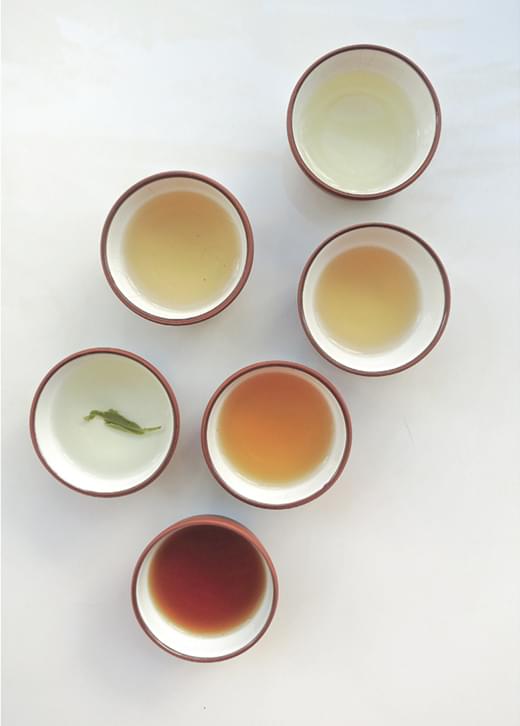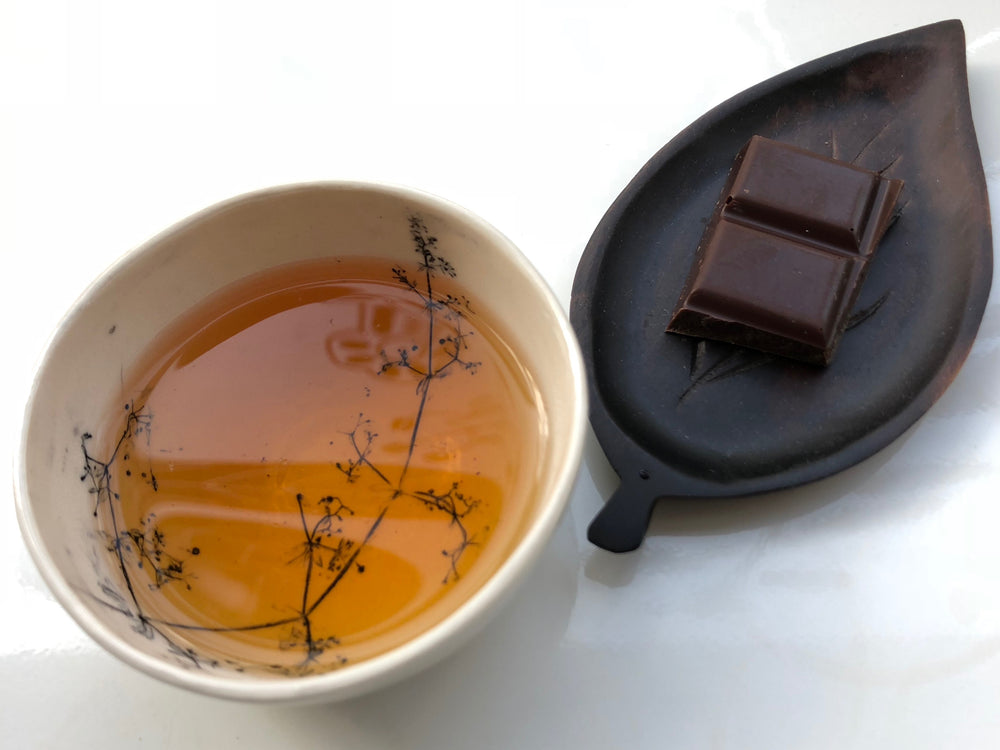Tea colors
With the same tea tree, Camellia sinensis, we can obtain all the colors of tea. It is during his work in the factory, equivalent to the cellar for wine and its vinification, that the producer will give birth to the colors of tea.
 Photo credits: Rebecca Rübcke for Portraits de Thés ed. Delachaux & Niestlé
Photo credits: Rebecca Rübcke for Portraits de Thés ed. Delachaux & Niestlébetween oxidation …
Browning, or more precisely enzymatic oxidation, is a natural process of plant aging that can be seen in the fall. Leaves, when they wither, turn progressively from green to brown, red fawn ... under the action of compounds contained in them, called oxidase enzymes. Thus, the young tea shoots change color but also taste! In the game of tea colors, green tea is not oxidized at all, it keeps its original green color, while black tea (called red in Asia) is totally oxidized: it takes a brown tint. As for the other colors, it is a more or less advanced oxidation, sometimes coupled with fermentation.
… and fermentation
For some teas, we also look for a real microbial fermentation. This is similar to the world of cheese or wine, since it is a process in which yeasts, bacteria or fungi intervene to develop the color and taste of the leaf. A kind of mold controlled and mastered by man!
White tea
Delicate
naturally oxidized
White tea is one of the least processed and most delicate teas to obtain. Indeed, once picked, the young shoots are left to wither for several days on large racks, outside in the shade, under the watchful eye of the producer who controls its evolution by sight and smell. The climate must be favourable, neither too hot, nor too dry, nor too humid. It can either dry naturally or be put in the oven for a few minutes to accelerate its drying and stabilize it. What happened during these days of wilting? The leaf begins to oxidize naturally and gradually takes on a green-gray tint, a subtle mixture of green and brown. Some are suitable for aging.
its thirst-quenching and sweet taste
White teas are generally light in the mouth with a little bitterness and a little bitterness more or less pronounced depending on the quality and origin. They are mild with dry vegetal aromas, and floral or fruity accents depending on the cultivar, the soil or the fineness of the harvest. The richer they are in leaves, the more robust they are.
Green tea
Fresh
non-oxidized
We try to prevent any enzymatic oxidation of green tea, but the famous oxidases are sensitive to heat: they are destroyed above 50°C. To obtain this variety of tea, it is sufficient to heat the freshly harvested young shoots for a short time, which stabilizes the tea and its color. This stabilizes the tea and its color, so that its taste does not change. This is called "fixing" the leaf. Two methods are used for this fixing:
- dry heat in a large wok placed on a brazier, or in a rotating cylinder where hot air is blown in. These methods are common in China;
- wet heat in steam ovens saturated with water vapor. This method is mainly used in Japan.
Then comes the rolling which gives the tea its final shape and color. Finally the drying. In China, the shoots can be rolled into pearls, flattened sticks or needles, twisted, tied together to reproduce flowers, shells, fruits... In Japan, the leaf must imitate a pine needle with a dark green glazed aspect. Green teas are generally fragile. It is best to keep them in a cool place and for some under vacuum. They can then be kept for several years. Green tea represents a little more than 20% of the world tea production.
its taste between sea and garden
Dry heat, humid heat, these factors will really influence the taste of tea independently of all the others: climate, soil, cultivar, etc. Green teas fixed with dry heat generally have roasted notes, cooked vegetables or chestnuts, velvety and tannin, while those fixed with moist heat have green vegetal notes (watercress, spinach) and marine notes with a slight acidity and texture for the grand crus.
Cyan or wulong tea
Fragrant
semi-oxidized
This family is between a green and a red tea. Since we play with the degree of oxidation of the leaf, we obtain teas with very different aromas. It is one of the most varied families and the richest in aromatic diversity. They are called wulong or blue-green teas. Personally, I prefer the term cyan to blue-green. The transformation process is a lighter formula than that of red tea, with oxidation stopped along the way by the final drying. We can thus have semi-oxidized wulong from 5% to 70% of the leaf. Some wulong are roasted in order to exacerbate the aromas of the leaves and to develop roasted notes. For great vintage wines, this roasting is also a way to preserve the wulong and to age it. We can therefore find in this family of teas old vintages roasted several times. It is also a way to "wake them up" when they have been forgotten for a while.
Its taste between fresh flowers and candied fruits
Depending on the season of harvest, their typicality varies, generally more vegetal in spring and more flowery-fruity in autumn. These two seasons are the most famous for wulong. Depending on the degree of oxidation and/or the degree of roasting, an infinite and powerful palette of fragrances emerges, ranging from floral notes such as fresh white flowers, plants or fruits such as peach for the lightly oxidized and lightly roasted teas, to vanilla, candied fruit and roasted notes for the strongly oxidized and roasted teas.
Black tea (called red tea in Asia)
Robust
totally oxidized
Called black tea in the West because of its dry dark brown leaves, it is called red tea in Far Asia (China, Korea, ...) because, once wet, the leaves take on a tawny hue. Contrary to the aim of green tea, we want to obtain a totally oxidized leaf. Two preliminary steps are necessary to activate this oxidation: wilting so that the leaf becomes elastic, easy to work with without being too broken, then rolling to get the juice out of the leaf and activate the oxidation reactions, like when you have fun rolling a blade of grass in your hands: it turns black! Once these two steps are over, the leaves are left on thick mats on the floor where they quietly continue to oxidize and turn brown for a few hours under the watchful eye and nose of the producer who decides when to stop this oxidation, simply by desiccating the leaf by passing it through an oven as for the other colors. Many black teas can improve over the years. Red/black tea represents 60% of the world's tea production.
Its woody and robust taste
The range of flavors is very wide because, depending on the country, the altitude, the harvesting season and the cultivar, the tastes vary greatly. Apart from the Darjeeling family with its lively vegetal notes, zesty for certain spring teas, black/red teas generally have aromatic notes known as woody, stewed, vanilla and roasted at the heart and bottom, with a well-structured mouthfeel.
Dark tea (called black in Asia)
Voluptuous
between oxidation and fermentation
Dark tea, known as black tea in Asia, of which pu er is the best known, is the result of a subtle interplay between oxidation and fermentation, more or less thorough during its manufacture, and then of the conditions of its maturation, or storage, over the years after its manufacture, which can be refined for many years for the grand crus.
In this case, it is not only a question of oxidation, but also of a true microbial fermentation involving bacteria and fungi. The first step, just after the harvest, is to wither for a few hours so that the leaves begin to dehydrate, and thus soften. The second step is, as with green tea, dry heat setting to "kill the green" or prevent enzymatic oxidation. This step can be more or less long with a less strong heat allowing not necessarily completely destroy all the enzymes. This can be done more or less strongly, which will induce thereafter a slow or not resumption of the natural oxidation of the leaf. Then the leaves are rolled to get the juice out and to allow a homogeneity of the ageing afterwards. They then take their characteristic oblong twisted shape. They are then stored in the open air for several hours to dry naturally slowly. The result is pu er sheng cha or raw pu er. When it is loose in its raw state it is called mao cha and can be stored in this way or compressed into cakes or bricks or other shapes and refined over the years. There is another type of pu er, the pu er shu cha or ripe pu er. For the latter, the leaves are rewetted, stored in piles covered with a tarpaulin, and left to ferment for several days, stirring them regularly. This is known as the wo dui (literally "wet pile") process. It is a kind of accelerated aging! This technique was developed in the 1970's to try to recover more quickly the characteristics of the aged raw pu er that had undergone a so-called Hong Kong storage, i.e. wet storage. This finally gave birth to another sub-family of pu er. It too can be in mao cha form or compressed and matured for several years.
from wood to undergrowth
Depending on whether it is raw or fired, dark tea has very variable and distinctive aromatic notes ranging from vegetal, sappy, zesty, sometimes even oriental notes evoking patchouli, cedar or sandalwood with a certain liveliness for a raw pu er called pu er sheng cha, to velvety notes of undergrowth, moss or leather for the ripe pu er called pu er shu cha.

